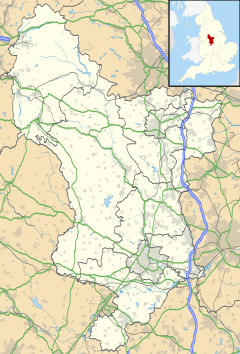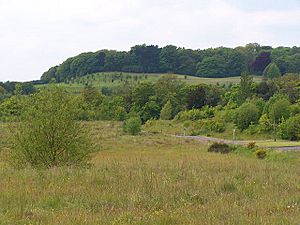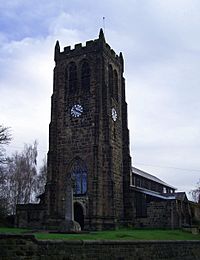Heanor facts for kids
Quick facts for kids Heanor |
|
|---|---|
 Heanor Town Hall (left), with St Lawrence's Church (right) |
|
| Population | 17,251 Whole administrative parish (2011 census) |
| OS grid reference | SK 43334 46528 |
| Civil parish | |
| District |
|
| Shire county | |
| Region | |
| Country | England |
| Sovereign state | United Kingdom |
| Post town | HEANOR |
| Postcode district | DE75 |
| Dialling code | 01773 |
| Police | Derbyshire |
| Fire | Derbyshire |
| Ambulance | East Midlands |
| EU Parliament | East Midlands |
| UK Parliament | |
Heanor is a town in Derbyshire, England. It is about 8 miles (13 km) north-east of Derby. Heanor and the nearby village of Loscoe together form the area called Heanor and Loscoe. In 2011, about 17,251 people lived here.
Contents
History of Heanor
The name Heanor comes from old English words. It means "place at the high ridge." In a very old book from 1086, called the Domesday Book, Heanor was written as Hainoure.
The Domesday Book said that Heanor had land for farming. There were also 11 villagers, 2 small farmers, and 3 free farmers. The town had a church and a mill. It also had meadows and woodlands.
In 1848, a book said Heanor had lots of coal and iron. Over 2,000 people worked in the coal mines. The town was on a hill between Derby and Mansfield. People also made silk, cotton, and lace products. About 800 people worked in these factories.
Heanor's main church, St Mary's, was very old. It had a tall tower with great views. The town also had other places of worship. The Market Place in Heanor started in the 1890s. This happened after the Heanor Hall estate was divided up.
How Heanor is Governed
Past Government
Around 1850, Heanor set up a local board to manage town services. In 1895, this area became an urban district. This meant it had its own local government. In 1899, the nearby area of Codnor and Loscoe joined Heanor.
This urban district lasted until 1974. Then, it became part of a new area called Amber Valley. In 1984, three new local areas were created. Heanor became part of the Heanor and Loscoe civil parish. In 1987, the Heanor and Loscoe Parish Council decided to call their area a town. Now, it is run by a town council and led by a town mayor.
Current Government
Since 1984, Heanor has had three levels of local government. The first is Derbyshire County Council for the whole county. The second is Amber Valley Borough Council for the district. The third is Heanor and Loscoe Town Council for the local parish.
Heanor is split into two areas for the County Council. These are Greater Heanor and Heanor Central. Currently, members from the Conservative Party represent both areas.
For the Amber Valley Borough Council, Heanor and Loscoe has three areas. These are Heanor East, Heanor West, and Heanor and Loscoe. Each area chooses two councillors.
Geography of Heanor
Heanor is about 8 miles (13 km) north-east of Derby. It is also about 9.5 miles (15 km) west-north-west of Nottingham. The town sits on a hill. Its height above sea-level ranges from 65 metres (213 ft) to 125 metres (410 ft).
The civil parish of Heanor and Loscoe covers most of Heanor town. However, some parts are in other parishes. For example, Heanor Gate Science College and some nearby streets are in Smalley parish. A small area of houses is in Shipley parish.
Heanor and Loscoe civil parish does not have any special conservation areas. But, 30 percent of the land is a green belt. This means it is protected from building. The area has one nature reserve and four wildlife sites. These are important for local nature.
Heanor's Economy
The most important type of work in Heanor is manufacturing. This means making things in factories. More than 20 percent of working people have jobs in manufacturing. The retail sector, which means shops, employs over 17 percent of people.
In the past, coal mining and making textiles (like cloth) were very big industries. But these industries have now become much smaller. In December 2013, the unemployment rate in Heanor was similar to the average for England.
The Matthew Walker factory is in Heanor Gate Industrial Park. It is famous for making Christmas puddings. This factory is now part of the 2 Sisters Food Group. Other companies in the park include Advanced Composites Group and Cullum Detuners Ltd.
You can find shops like Tesco, Aldi, and Boyes in Heanor. There is also a small outdoor market on Fridays and Saturdays. Heanor joins up with the nearby town of Langley Mill.
Population Information
In the 2011 census, Heanor and Loscoe civil parish had 7,512 homes. There were 7,221 households, and 17,251 people living there. About 18.7 percent of residents were under 16 years old. This is very close to the average for England. About 16.5 percent of residents were 65 or older.
Most people in Heanor were white British. About 1.84 percent of residents were from non-white backgrounds. This is less diverse than the average for England. Christianity was the most common religion, with 56.4 percent of people saying they were Christian. About 35.6 percent said they had no religion.
Education in Heanor
Heanor has several schools for different age groups. There are two infant schools: Corfield Church of England Infant School and Marlpool Infant School.
The town has three primary schools: Coppice Primary School, Howitt Primary Community School, and Loscoe Church of England Primary School. There are also two junior schools: Marlpool Junior School and Mundy Church of England Voluntary Controlled Junior School.
For older students, there is one secondary school: Heanor Gate Spencer Academy. Heanor Grammar School used to be near the market place. It was part of Derby College but is now closed. A book about the history of this school was published in 2008.
Sport and Leisure
Shipley Country Park is a large park south and west of the town. It has a riding school and three lakes. The park used to be part of a big estate owned by the Miller-Mundy family. Later, it was used for coal mining. In the 1970s, it was cleaned up and given to the county council.
Heanor has a local football team called Heanor Town Football Club. They are known as the Lions. The club started in 1883. Famous players like Nigel Clough and Nigel Pearson used to play for them. The football club shares its grounds with the Heanor Town Cricket Club.
Heanor Town Cricket Club has played cricket since 1843. In 2003, they joined with another club. They now play at the Underwood Miners Welfare ground. Heanor Clarion Cycling Club started in 1934. They often meet on Wednesday evenings.
Transport in Heanor
Langley Mill train station is about 1 mile (1.6 km) east of Heanor. From here, you can catch trains to Nottingham, Sheffield, and other places. In the past, Heanor had its own railway lines, but these were closed to passengers in the 1920s and 1930s.
Bus routes connect Heanor to Nottingham, Derby, Mansfield, and other nearby towns. The main bus company is Trent Barton. Another company, Notts + Derby, also runs one route.
The closest international airport is East Midlands Airport. It is about 18 miles (29 km) away.
Media
Local news and TV shows for Heanor come from BBC East Midlands and ITV Central. These signals are received from the Waltham TV transmitter.
You can listen to local radio stations like BBC Radio Derby, Smooth East Midlands, and Capital Midlands. There are also Hits Radio East Midlands, Greatest Hits Radio Midlands, and Amber Sound FM. Amber Sound FM is a local community radio station.
The local newspaper used to be the Ripley and Heanor News. It came out on Thursdays. In 2021, it became part of the Derbyshire Times newspaper.
Notable People from Heanor
Many interesting people have connections to Heanor:
- Billy Bestwick (1875–1938), a cricketer, was born in Heanor.
- George William Bissill (1896–1973), a painter, went to school in Heanor.
- Sir Thomas Bloodworth (1620-1682), a merchant and politician, was born in Heanor. He was the Lord Mayor of London during the Great Fire of London.
- Sir Richard William Barnes Clarke (1910–1975), a journalist and civil servant, was born here.
- Henry Garnet (1555–1606), a Jesuit, was born in Heanor. He was involved in the Gunpowder Plot.
- William Gregg (1890–1969), born and died in Heanor, won a special award for bravery in 1918.
- The Howitt brothers: William Howitt (1792–1879), an author, Richard (1799–1869), a poet, and Godfrey (1800–1873), who studied insects, were all born in Heanor.
- Mary Howitt (1799–1888), an author, lived in Heanor.
- Douglas Keen (1913–2008) designed Ladybird Books. He lived in Heanor and created the first book in his kitchen.
- Samuel Roper (died 1658), who studied old things, was born in Heanor.
- Edward Smith (1819–1874), a doctor and writer, was born in Heanor.
- John Varley (1740–1809), who built canals, was born in Heanor.
- Samuel Watson (around 1662–1715), a sculptor, was born in Heanor.
Important Buildings
There are ten buildings in Heanor and Loscoe that are considered important for their history or design. Two are in Loscoe and eight are in Heanor. The Church of St Lawrence in Heanor is very special. It was built in the 15th century, but it was changed in the 1800s and around 1980. Other important buildings include Heanor Town Hall.
Images for kids
See also
 In Spanish: Heanor para niños
In Spanish: Heanor para niños





